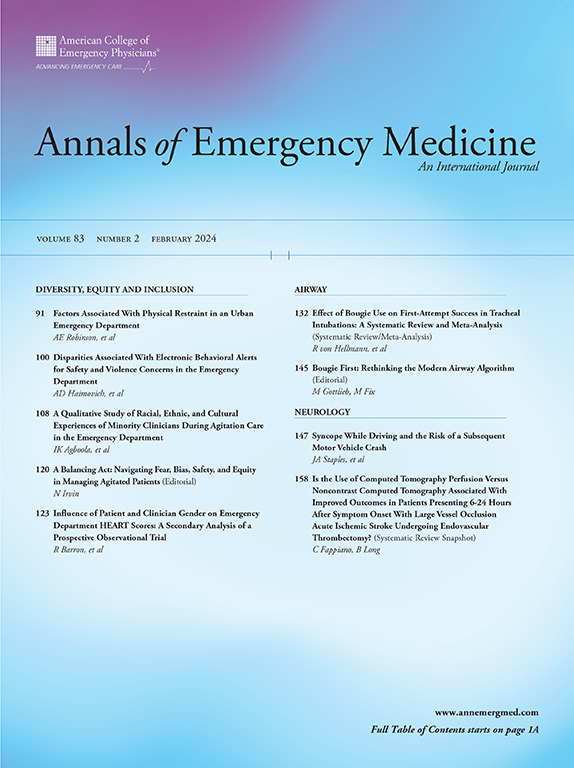胶质纤维酸性蛋白和泛素c端水解酶L1对急性外伤性颅内病变的诊断准确性研究。
IF 5
1区 医学
Q1 EMERGENCY MEDICINE
引用次数: 0
摘要
目的探讨胶质原纤维酸性蛋白(GFAP)和泛素c端水解酶L1 (UCH-L1)在急诊科钝性创伤后行脑计算机断层扫描(CT)的患者中检测具有临床意义的急性创伤性颅内病变的准确性。方法:我们对1867例年龄大于或等于18岁的患者进行了回顾性研究,这些患者均有创伤相关的主诉,接受了脑CT检查,并在损伤后小于或等于24小时内收集了残留样本。我们使用雅培i-STAT TBI血浆试验评估GFAP和UCH-L1的诊断准确性。此外,我们评估了关键临床亚组的诊断准确性,以确定拟议的实施队列,并评估了该队列中生物标志物的诊断准确性。结果1867例患者中,49例(2.6%)有临床显著的外伤性颅内病变。GFAP或UCH-L1升高的敏感性为96%(95%置信区间[CI] 86%至99%),特异性为30% (95% CI 28%至32%),阳性似然比(LR+)为1.38 (95% CI 1.29至1.47),阴性似然比(LR-)为0.13 (95% CI 0.03至0.53)。2例患者有临床意义的CT病变,GFAP或UCH-L1均未升高。在拟议的实施队列中,年龄大于或等于18岁且无凝血功能升高的GFAP或UCH-L1的敏感性为100% (95% CI 86%至100%),特异性为33% (95% CI 31%至36%),LR+为1.50 (95% CI 1.44至1.56),LR-为0.00 (95% CI 0.00至0.95)。结论损伤后≤24小时血浆GFAP和UCH-L1联合检测对临床意义重大的急性外伤性颅内病变具有较高的敏感性。需要进一步的研究来确定在拟议的实施队列中部署这些生物标志物是否会减少可避免的脑CT扫描。本文章由计算机程序翻译,如有差异,请以英文原文为准。
Glial Fibrillary Acidic Protein and Ubiquitin C-Terminal Hydrolase L1 for Acute Traumatic Intracranial Lesions: The PIONEER Diagnostic Accuracy Study.
OBJECTIVE
To determine the diagnostic accuracy of glial fibrillary acidic protein (GFAP) and ubiquitin C-terminal hydrolase L1 (UCH-L1) for detecting clinically significant acute traumatic intracranial lesions in emergency department patients who undergo brain computed tomography (CT) after blunt trauma.
METHODS
We conducted a retrospective study of 1,867 patients aged more than or equal to 18 years, who presented with trauma-related complaints, underwent brain CT, and had residual samples collected less than or equal to 24 hours postinjury. We evaluated the diagnostic accuracy of GFAP and UCH-L1 using the Abbott i-STAT TBI Plasma test. Additionally, we assessed diagnostic accuracy within key clinical subgroups to define a proposed implementation cohort and assessed the diagnostic accuracy of the biomarkers within this cohort.
RESULTS
Among 1,867 patients, 49 (2.6%) had clinically significant traumatic intracranial lesions. Elevated GFAP or UCH-L1 demonstrated 96% sensitivity (95% confidence interval [CI] 86% to 99%), 30% specificity (95% CI 28% to 32%), positive likelihood ratio (LR+) of 1.38 (95% CI 1.29 to 1.47), and negative likelihood ratio (LR-) of 0.13 (95% CI 0.03 to 0.53). Two patients had clinically significant CT lesions without elevated GFAP or UCH-L1. In the proposed implementation cohort of adults aged more than or equal to 18 years without coagulopathy elevated GFAP or UCH-L1 had a sensitivity of 100% (95% CI 86% to 100%), specificity of 33% (95% CI 31% to 36%), LR+ of 1.50 (95% CI 1.44 to 1.56), and LR- of 0.00 (95% CI 0.00 to 0.95).
CONCLUSION
Plasma GFAP and UCH-L1 in combination, measured ≤24 hours postinjury, demonstrated high sensitivity for clinically significant acute traumatic intracranial lesions. Further research is needed to determine whether deploying these biomarkers in the proposed implementation cohort decreases avoidable brain CT scans.
求助全文
通过发布文献求助,成功后即可免费获取论文全文。
去求助
来源期刊

Annals of emergency medicine
医学-急救医学
CiteScore
8.30
自引率
4.80%
发文量
819
审稿时长
20 days
期刊介绍:
Annals of Emergency Medicine, the official journal of the American College of Emergency Physicians, is an international, peer-reviewed journal dedicated to improving the quality of care by publishing the highest quality science for emergency medicine and related medical specialties. Annals publishes original research, clinical reports, opinion, and educational information related to the practice, teaching, and research of emergency medicine. In addition to general emergency medicine topics, Annals regularly publishes articles on out-of-hospital emergency medical services, pediatric emergency medicine, injury and disease prevention, health policy and ethics, disaster management, toxicology, and related topics.
 求助内容:
求助内容: 应助结果提醒方式:
应助结果提醒方式:


